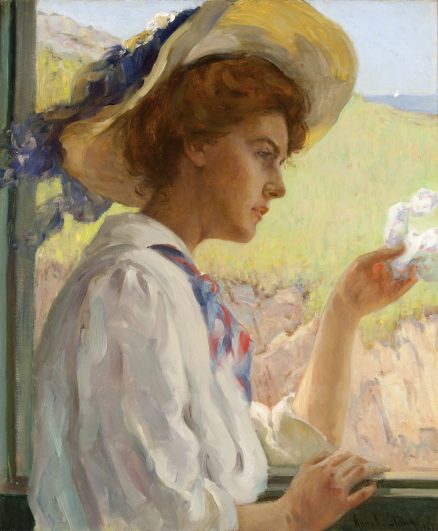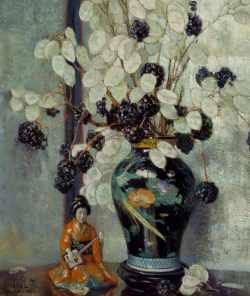- Categories
- Figural works
- Women
- Women artists
- Zoom in on Artwork
- Print Page
- Email Page to Friend
In the first decade of the twentieth century Anna L. Stacey painted several half-length images of women or girls against landscape backdrops or framed in doorways or windows, often giving them titles that hint at narrative. As she observed in a 1903 interview, “An attractive, telling title goes a great way toward interesting people in a picture.”i Bon Voyage is one such work: it features a pretty young woman leaning out the open window of what is presumably a railway car to wave a white handkerchief in farewell to an unseen observer. While the painting’s title emphasizes the start of a journey, the image itself focuses on a parting from companions—perhaps a lover—and the implied ending of a seaside vacation. Seen through the train window, the frame of which closely corresponds to the edges of the composition, the landscape backdrop consists of a rising bluff and a glimpse of calm ocean under a fair-weather sky, a background that Stacey used for at least one other painting, In the Doorway (1907; formerly Friedman Collection). Against this sun-drenched landscape the young woman’s face is relatively shadowed and her expression is pensive, with perhaps a hint of melancholy. Broad, fluid brushstrokes enliven her white summer blouse, the blue scarf festooning her broad-brimmed hat, and her fluttering handkerchief.
In 1907, the year Stacey painted Bon Voyage, she and her artist-husband John F. Stacey spent the summer in Gloucester, Massachusetts, which they first visited in 1905. The site of a busy artists’ community, the town and its surroundings provided numerous subjects for artists. Gloucester was also a venerable vacation spot to which most visitors, including the Staceys, traveled by train—like the woman in this image. Gloucester and other northeastern coastal spots attracted the well-to-do Chicagoans among whom both Staceys found patrons, making Bon Voyage something of a nostalgic souvenir of artist’s and patrons’ shared experience. The painting was among a group of Gloucester paintings that Anna exhibited in Chicago in 1908 and that demonstrated, according to one approving critic, that Stacey “paints because she was born that way.”ii This work’s charmingly evocative subject demonstrates the artist’s knack for compositions that made her a favorite among the Chicago clubwomen of her day.
Wendy Greenhouse, PhD
Donated by M. Christine Schwartz to the Art Institute of Chicago, Chicago, Illinois, in 2023
i “Pictures and Titles,” Chicago Tribune, May 3, 1903.
ii Henry Charles Payne, “Art Exhibit Is Most Worthy,” Chicago Journal, Feb. 4, 1908.

